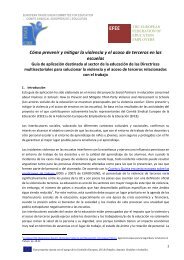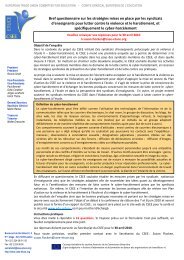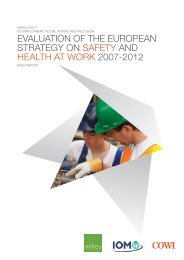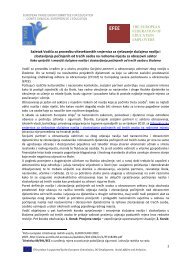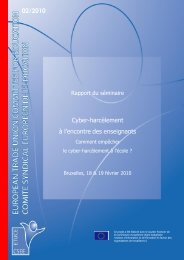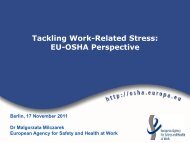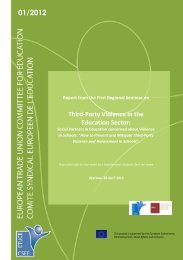Workplace Violence and Harassment: a European Picture
Workplace Violence and Harassment: a European Picture
Workplace Violence and Harassment: a European Picture
Create successful ePaper yourself
Turn your PDF publications into a flip-book with our unique Google optimized e-Paper software.
<strong>Workplace</strong> <strong>Violence</strong> <strong>and</strong> <strong>Harassment</strong>: a <strong>European</strong> <strong>Picture</strong>In studying the prevalence of harassment, sometimes third parties, sometimes onlyco-workers, supervisors/managers <strong>and</strong> subordinates are mentioned as potentialperpetrators.Methods to assess different forms of third-party violence, for example in healthcare(58) <strong>and</strong> retail (59) have been developed <strong>and</strong> used. The Violent Incident Form (VIF)(58) is designed for implementation in high-risk workplaces in the healthcare sector. Achecklist summarises key aspects of a violent incident, identifying the circumstances,perpetrator, event, <strong>and</strong> consequences. The form measures all levels of violentbehaviour, including the events that do not result in any physical harm, <strong>and</strong> alsoreports the violent incidents by staff members.Despite these difficulties, there is more <strong>and</strong> more data available from different sources(<strong>European</strong> Surveys, National Surveys, sector-specific studies) that mark the trends inthis area, increasingly recognising the nature of the phenomenon of work-relatedviolence <strong>and</strong> its severity.EU-OSHA’s <strong>European</strong> Survey of Enterprises on New <strong>and</strong> Emerging Risks (ESENER) 6 asksboth managers <strong>and</strong> workers’ safety <strong>and</strong> health representatives about the way safety<strong>and</strong> health risks are managed in their workplace, with a particular focus onpsychosocial risks, i.e. work-related stress, violence <strong>and</strong> harassment. In spring 2009, atotal of 28 649 managers <strong>and</strong> 7 226 health <strong>and</strong> safety representatives were interviewedin the 31 countries covered: the EU-27 <strong>and</strong> Croatia, Norway, Switzerl<strong>and</strong> <strong>and</strong> Turkey(185).E u r o p e a n Ag e n c y f o r Sa f e t y a n d He a l t h a t Wo r kA v a i l a b i l i t y o f s t a t i s t i c a l i n f o r m a t i o n 3.1.According to the Focal Point survey, statistical information on third-party violence isavailable in 10 <strong>European</strong> countries. Most of the negative answers came from therepresentatives of new EU Member States (Table 6).6 Developed with the support of governments <strong>and</strong> social partners at <strong>European</strong> level, ESENER aims toassist workplaces across Europe to deal more effectively with safety <strong>and</strong> health <strong>and</strong> to providepolicymakers with cross-nationally comparable information relevant for the design <strong>and</strong>implementation of new policies. As well as looking at management practices, ESENER explores indetail how workers are involved in the management of safety <strong>and</strong> health at work, which is animportant factor in the successful implementation of preventive measures at workplace level.Detailed results are available online (http://www.esener.eu) <strong>and</strong> the ESENER dataset is accessibleonline via the UK Data Archive (UKDA) of the University of Essex (http://www.data-archive.ac.uk/Introduction.asp). Further analyses will be carried out throughout 2010 <strong>and</strong> will be published in 2011.45




